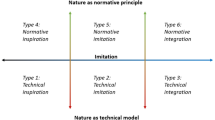Abstract
The relation between nature and design has a millennial history. While art found aesthetic inspiration and proportion in nature, technique used natural principles for inventions, adaptable to everyday life or industrial production. Design pushed further the research in terms of ergonomics, dynamics, functionality and efficacy. Therefore, the aim to define and order the categories of inspiration sources taken from nature may appear as useful. Form, geometry, and proportion may appear as the easiest way to study and transmit the principles of nature (an approach used in biomimicry). However, the dynamic study of natural mechanisms may change the perspective. A different approach is brought by understanding natural substance as composed of interconnected small elements, creating perfectly functional networks. And last but not least, let us not forget about the beauty of nature, about its inner proportion and mathematical composition that bring absolute harmony.
The present ecologic crisis obliges us to be smart and resilient and bionics appeared to be one of the solutions to this crisis. The strategic concept of sustainable development, consecrated by the Summit from Rio in 1992, produced the vision of sustainable design. Later on, it was refined and turned into the notion of ecologically sustainable development (and design), such as formulated by R. Harding in 2006. The present discourse produces a concrete onset for this concept and illustrates each defined category with a specific design project inspired by nature, presented as a study case. The final purpose is to approach the study of nature in a conscient way, using a series of effective tools. This may lead to a more intelligent and efficient design conception at any scale (from urbanism and landscape design to conception of buildings, interior architecture, or object design), in terms of general thinking, form, elected materials, and efficient functioning. The easiest way to be ecologically sustainable is by correctly understanding and applying the lesson of nature.
Access this chapter
Tax calculation will be finalised at checkout
Purchases are for personal use only
Similar content being viewed by others
References
Benyus, J. (2002). Biomimicry: Innovation inspired by nature. William Morrow & Company.
Harding, R. (2006). Ecologically sustainable development: Origins, implementation and challenges. Desalination, 187(1–3), 229–239.
Keller, R. S. (2018). Nature by design. The practice of biophilic design. Yale University Press.
Laurenza, D., & Taddei, M. (2006). Leonardo’s machines: Da Vinci’s inventions revealed. David & Charles.
Tanov, E. (2018). Design by nature: Creating layered, lived-in spaces inspired by the natural world. Ten Speed Press.
Yeang, K. (2006). Ecodesign: A manual for ecological design. Wiley-Academy.
Author information
Authors and Affiliations
Editor information
Editors and Affiliations
Rights and permissions
Copyright information
© 2023 The Author(s), under exclusive license to Springer Nature Switzerland AG
About this chapter
Cite this chapter
Dușoiu, EC. (2023). Categories of Natural Principles and Their Adaptation to Bionic Design. In: Cervera Sardá, M.R., Dușoiu, EC., Lascu, T.N. (eds) Architecture Inspired by Nature. Springer, Cham. https://doi.org/10.1007/978-3-031-33144-2_4
Download citation
DOI: https://doi.org/10.1007/978-3-031-33144-2_4
Published:
Publisher Name: Springer, Cham
Print ISBN: 978-3-031-33143-5
Online ISBN: 978-3-031-33144-2
eBook Packages: Literature, Cultural and Media StudiesLiterature, Cultural and Media Studies (R0)




